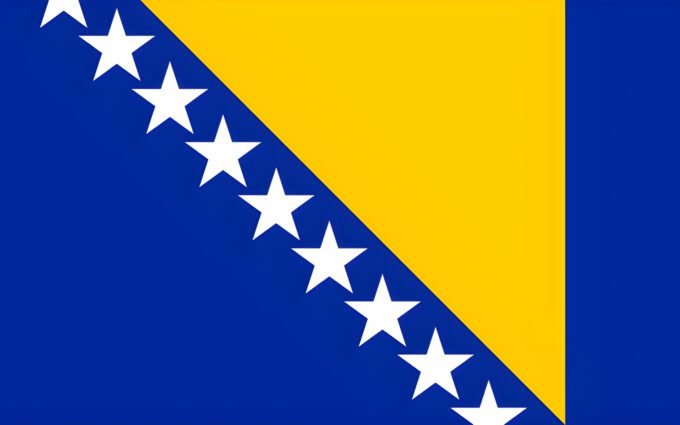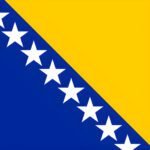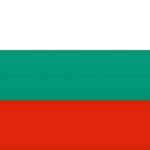Bosnia and Herzegovina Flag: National Flag of Bosnia and Herzegovina

Introducing the National Flag of Bosnia and Herzegovina: Symbol of Unity and Diversity
The national flag of Bosnia and Herzegovina is a significant symbol of the country’s identity and history. It represents the unity and diversity of the Bosnian people and their rich cultural heritage. The flag consists of a blue background with a yellow triangle at the hoist side and a series of white stars arranged in an arc.
A) Why did Bosnia and Herzegovina change their flag?
Bosnia and Herzegovina changed their flag in order to symbolize their independence and national identity. The previous flag, which was used during the time when Bosnia and Herzegovina was part of Yugoslavia, no longer represented the aspirations and values of the newly independent country. The new flag was designed to reflect the diversity and unity of the nation, with its blue background representing peace and the stars symbolizing Europe.
1. Is Bosnia and Herzegovina two countries?
No, Bosnia and Herzegovina is not two separate countries. It is a single country located in the Balkan region of Europe. The name Bosnia and Herzegovina refers to the two main historical regions that make up the country. Bosnia is the northern region, while Herzegovina is the southern region. Together, they form the country of Bosnia and Herzegovina.
2. What country changed their flag the most?
There isn’t a specific country that has changed their flag the most. Many countries have changed their flags throughout history for various reasons such as political changes, regime changes, or to reflect a new national identity. Some examples of countries that have changed their flags multiple times include South Africa, Germany, and Russia.
3. What flag is this “ba”?
The flag with the abbreviation “BA” represents Bosnia and Herzegovina. The flag consists of a blue background with a yellow triangle on the left side and a series of white stars in the upper right corner.
4. Which country has the most beautiful flag?
Beauty is subjective, and different people may have different opinions on which country has the most beautiful flag. However, some commonly mentioned flags for their aesthetic appeal include the flag of Japan, with its simple and elegant design featuring a red circle on a white background, and the flag of Canada, known as the “Maple Leaf” flag, which features a red maple leaf on a white square with red borders.
5. What is the oldest flag in the world?
The oldest flag in the world that is still in use today is believed to be the flag of Denmark. The Danish flag, also known as the Dannebrog, has a red background with a white Scandinavian cross extending to the edges of the flag. According to legend, the flag fell from the sky during a battle in the early 13th century and became a symbol of Danish national identity.
6. What is the most controversial flag in the world?
One of the most controversial flags in the world is the flag of the Confederate States of America, also known as the Confederate flag. This flag, which features a blue diagonal cross with white stars on a red background, is associated with the Confederate states that seceded from the United States during the American Civil War. The flag is seen by many as a symbol of racism and oppression, while others argue that it represents Southern heritage and pride.
7. What’s the prettiest flag?
Beauty is subjective, and different people may have different opinions on which flag they consider to be the prettiest. Some commonly mentioned flags for their aesthetic appeal include the flag of Brazil, with its vibrant green, yellow, and blue colors, and the flag of Nepal, which is unique in shape and features a combination of crimson, blue, and white.
8. What is the coolest flag in history?
The coolest flag in history is a subjective opinion and can vary depending on personal preferences. However, some flags that are often considered cool due to their historical significance or unique design include the Jolly Roger flag used by pirates, the flag of the Soviet Union with its iconic hammer and sickle symbol, and the flag of the United States with its stars and stripes design.
9. When did Bosnia and Herzegovina change their flag?
Bosnia and Herzegovina changed their flag on February 4, 1998. This change was made to symbolize the country’s independence and to create a flag that better represented the values and aspirations of the newly independent nation.
10. Why did the flag change?
The flag of Bosnia and Herzegovina changed to symbolize the country’s independence and to create a new national identity. The previous flag, which was used during the time when Bosnia and Herzegovina was part of Yugoslavia, no longer represented the aspirations and values of the newly independent country. The new flag was designed to reflect the diversity and unity of the nation, with its blue background representing peace and the stars symbolizing Europe.
11. What was the original flag of Bosnia?
The original flag of Bosnia was a white flag with six golden fleur-de-lis symbols arranged in a triangle shape. This flag was used during the medieval Bosnian Kingdom, which existed from the 12th century until the Ottoman conquest in the 15th century. The fleur-de-lis symbols represented the royal power and authority of the Bosnian kings.
12. Why are there Croatian flags in Bosnia?
In Bosnia and Herzegovina, there are areas with a significant Croatian population, particularly in the southern region of Herzegovina. In these areas, it is common to see Croatian flags being displayed alongside the flag of Bosnia and Herzegovina. The Croatian flag consists of three horizontal stripes of red, white, and blue.
B) Why is Bosnia also Herzegovina?
The name Bosnia and Herzegovina refers to the two main historical regions that make up the country. Bosnia is the northern region, while Herzegovina is the southern region. The two regions have different historical, cultural, and geographical characteristics, but they were merged together under the same administrative entity during the time of Yugoslavia and have remained united since the country’s independence.
1. Is Bosnia still communist?
No, Bosnia and Herzegovina is not a communist country. After the collapse of Yugoslavia in the early 1990s, Bosnia and Herzegovina transitioned to a democratic system of government. Today, it is a parliamentary republic with a multi-party political system.
2. Which country has 3 presidents?
Bosnia and Herzegovina is the country that has three presidents. The country’s presidency consists of three members, each representing one of the three main ethnic groups in the country: Bosniaks, Croats, and Serbs. The presidency operates on a rotating basis, with each member serving for a specific period of time.
3. What side was Bosnia on in WWII?
During World War II, Bosnia and Herzegovina was part of the Kingdom of Yugoslavia, which was invaded and occupied by Axis powers. The country was initially divided between Nazi Germany and Fascist Italy, with the Independent State of Croatia, a puppet state established by the Axis powers, controlling parts of Bosnia and Herzegovina. However, there were also resistance movements in Bosnia and Herzegovina that fought against the Axis occupation.
4. Who did Bosnia go to war with?
Bosnia and Herzegovina experienced a devastating war in the 1990s following the breakup of Yugoslavia. The war involved multiple parties, including the Bosnian Serb forces, the Bosnian Croat forces, and the Bosniak (Bosnian Muslim) forces. The war resulted in widespread ethnic cleansing, atrocities, and the loss of thousands of lives.
5. Who were the “bad guys” in the Bosnian war?
It is important to note that referring to any side as the “bad guys” in a complex conflict like the Bosnian war is an oversimplification. The war in Bosnia and Herzegovina was characterized by numerous war crimes and human rights abuses committed by all sides involved. The conflict involved multiple ethnic and political factions, each with their own grievances and objectives. The war was marked by atrocities such as ethnic cleansing, mass killings, and the siege of Sarajevo.
6. Did the US end the Bosnian war?
The Bosnian war officially ended with the signing of the Dayton Agreement in 1995. The United States played a significant role in brokering the peace agreement, along with other international actors. The Dayton Agreement established a framework for peace in Bosnia and Herzegovina, including the division of the country into two semi-autonomous entities: the Republika Srpska and the Federation of Bosnia and Herzegovina.
7. Which country does not have a Prime Minister?
Bosnia and Herzegovina is one of the countries that does not have a Prime Minister. Instead, the country has a tripartite presidency, consisting of three members who rotate the position of the Chair of the Presidency. The presidency serves as the collective head of state and government.
8. Who rules Bosnia?
Bosnia and Herzegovina has a complex system of government, with power shared between the central government and the two semi-autonomous entities: the Republika Srpska and the Federation of Bosnia and Herzegovina. The country’s government is structured as a parliamentary republic, with a multi-party system and a rotating presidency representing the three main ethnic groups.
9. What countries only have a president?
Several countries around the world have a political system where the head of state is a president without a Prime Minister. Some examples of countries that only have a president include the United States, France, Russia, Brazil, and Mexico. In these countries, the president serves as both the head of state and the head of government.
C) What is Bosnia and Herzegovina called now?
Bosnia and Herzegovina is still called Bosnia and Herzegovina. It is a country located in the Balkan region of Europe.
1. What is Yugoslavia now called?
After the breakup of Yugoslavia in the early 1990s, the country of Yugoslavia ceased to exist. The territories that were part of Yugoslavia became independent countries, including Bosnia and Herzegovina, Croatia, Serbia, Slovenia, Montenegro, North Macedonia, and Kosovo.
2. Why is Croatia divided by Bosnia?
Croatia and Bosnia and Herzegovina share a border, and the division between the two countries is a result of historical and geographical factors. The border between Croatia and Bosnia and Herzegovina was established during the breakup of Yugoslavia and the subsequent wars in the 1990s. The border was determined based on ethnic and territorial considerations, as well as negotiations and agreements between the two countries.
3. What religion is Bosnia?
Bosnia and Herzegovina is a diverse country with a mix of religious affiliations. The three main religious groups in the country are Islam, Christianity (both Catholic and Orthodox), and Judaism. The majority of the population identifies as Muslim, followed by Orthodox Christians and Catholics.
4. What did Croatia used to be called?
Croatia has a long history, and throughout different periods, it has been known by different names. In ancient times, the region was part of the Roman Empire and was known as Pannonia. In the Middle Ages, it was part of the Kingdom of Croatia, which later joined with the Kingdom of Hungary to form the Union of Croatia and Hungary. During the time of Yugoslavia, it was known as the Socialist Republic of Croatia. Since gaining independence in 1991, it is officially known as the Republic of Croatia.
5. What did Serbia used to be called?
Serbia has a rich history and has been known by different names throughout different periods. In ancient times, the region was inhabited by various tribes and was part of the Roman Empire. In the Middle Ages, it was part of the Serbian Kingdom and later the Serbian Empire. During the time of Yugoslavia, it was known as the Socialist Republic of Serbia. Since the breakup of Yugoslavia, it is officially known as the Republic of Serbia.
6. What was Croatia called before 1991?
Before 1991, Croatia was part of the Socialist Federal Republic of Yugoslavia. It was one of the six socialist republics that made up Yugoslavia. After the breakup of Yugoslavia, Croatia declared independence and became an independent country.
Conclusion
The national flag of Bosnia and Herzegovina is a powerful symbol that represents the unity, diversity, and aspirations of the Bosnian people. Its design and symbolism reflect the country’s complex history and its desire for peace, stability, and integration with Europe. By understanding the significance of the flag, we can appreciate the rich cultural heritage and identity of Bosnia and Herzegovina.
Categories : Bosnia and Herzegovina
Views : 45 Views
Downloads : 0
Tags : Bosnia and Herzegovina Flag
Author : Admin
Description : Download Bosnia and Herzegovina Flag: National Flag of Bosnia and Herzegovina HD Widescreen Flag from the above resolutions from the directory Bosnia and Herzegovina. Posted by admin on May 1, 2024 If you don’t find the exact resolution you are looking for, then go for Original or higher resolution which may fits perfect to your desktop.
Rate This Flag:Download Flag
HD Resolution : 1280x720 1366x768 1600x900 1920x1080 2560x1440
Mobile VGA : 240x320 480x640 320x240 640x480 Mobile iPhone : 960x640 1136x640 1134x750 2208x1242
Tablet Android/iPad : 1024x768 1280x1280




Comments